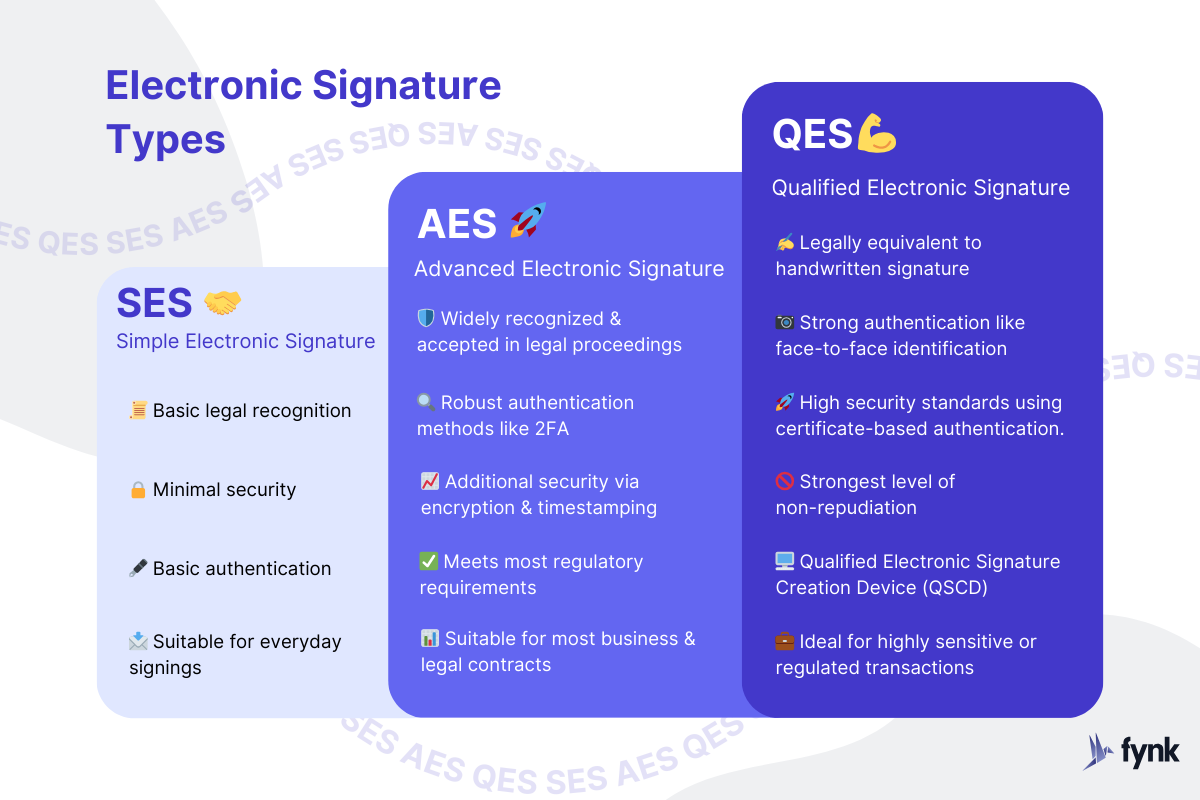
Electronic Signature Legality
14 min read
Electronic signatures are widely accepted, admissible, and legally binding in most countries around the world. However, there might be slight differences in the governing regulations in each country. In this guide, we’ll explore these laws, from eIDAS in the EU to ESIGN and UETA in the United States, to understand the legal status of eSignatures. We’ll also examine what happens when a conflict arises, whether you can eSign a contract internationally, and when you cannot sign something electronically. So, if you want to confidently sign your contracts electronically the next time, let’s go through all these nuances.
Table of contents
- Are Electronic Signatures Legally Binding?
- Electronic Signature Legality In the EU 🇪🇺
- Electronic Signature Legality in the USA 🇺🇸
- Enforcing eSignature Laws in the US: ESIGN & UETA
- 1. ESIGN Act
- 2. UETA Act
- Types of Electronic Signatures in the USA Law
- Legal Status of Electronic Signatures in the US
- When You Cannot Use eSignature in the USA?
- International Recognition of eSignatures in the US
- What Happens If a Conflict Arises Regarding eSignatures?
- Updates on ESIGN & UETA Regulation
- Electronic Signature Legality in the UK 🇬🇧
- fynk Compliance
- Conclusion
- Frequently Asked Questions
Are Electronic Signatures Legally Binding?
Yes, Electronic Signatures are widely recognizable, acceptable, and enforceable in most countries worldwide. However, some countries might only require a special type of eSignature to consider it to be legally binding.
🧠 Did You Know? The emoji “👍” is considered as a valid electronic signature in Canada?
Electronic Signature Legality In the EU 🇪🇺
👩🏻⚖️ Regulation: eIDAS regulation (EU) No 910/2014 + eIDAS 2.0
🔏 eSignature Types: Simple, Advanced, and Qualified
⚖️ Legal Status: Legally binding and admissible in proceedings
🌍 Cross-border Recognition: Valid across EU member states, and most countries
Enforcing eSignature Regulation in EU: eIDAS
eIDAS Regulation (EU) No 910/2014, short for “Electronic IDentification, Authentication, and Trust Services,” is the governing regulation for electronic signatures in the EU.
eIDAS made it simpler for individuals and businesses across the EU to use electronic signatures for legal purposes and transactions. eIDAS helps to remove legal barriers that complicate digital transactions between EU countries by defining the criteria that make an eSignature legally viable.
Types of Electronic Signatures in eIDAS
eIDAS introduced three main types of eSignatures:
Simple Electronic Signatures (SES): Defined broadly as any data in electronic form that is associated with other electronic data and used by the signatory for signing.
Advanced Electronic Signatures (AES): Must uniquely link to the signatory, identify them, and detect any subsequent data changes.
Based on Article 26 of eIDAS, an advanced electronic signature is:
- Unique to the signatory
- Identifies the signatory
- Created using electronic signature data
- Linked to the signed data, so any changes are trackable
- Qualified Electronic Signatures (QES): The equivalent of wet signatures and a type of AES. They require a qualified electronic signature creation device (QSCD) and a qualified certificate from a qualified trust service provider (QTSP) for creation and recognition.


A QSCD is a trusted hardware or software installed on your device for signing documents securely. A Qualified Certificate is generated and validated by a QTSP, which securely manages and stores the signers’ data.
QES offers the highest level of security in electronic signatures because they are unique, confidential, and protected from forgery.
Legal Status of Electronic Signatures in eIDAS
Article 25 of eIDAS recognizes all three types of electronic signatures (SES, AES; and QES) as legally binding. It says: An electronic signature shall not be denied legal effect and admissibility as evidence in legal proceedings solely on the grounds that it is in electronic form or does not meet the requirements for a qualified electronic signature.
and
A qualified electronic signature shall have the equivalent legal effect of a handwritten signature.
So, in general, all forms of electronic signatures, even the basic forms, are legally binding in the European Union member states.
✨ Pro Tip: Always use a Qualified Electronic Signature to sign documents that are highly important and risky.
International Recognition of eSignatures under eIDAS
Based on eIDAS, electronic signatures recognized in one EU member state are valid and recognized in all others.
For Qualified Electronic Signatures (QES), you can select a trusted service provider from any EU member state, regardless of your country of residence.
If you are not European, you can still use electronic signatures and obtain a qualified certificate from any EU member state.
Each member state is allowed to set other rules and regulations on using electronic signatures, but they should not contradict the eIDAS regulation.
If you are dealing with documents involving parties from non-EU countries, consider the following:
- Legal Framework Differences: Non-EU countries may have distinct legal frameworks governing electronic signatures and transactions. For example, the USA recognizes various authentication methods accepted by other countries.
- Mutual Recognition Agreements: Some countries have mutual recognition agreements or treaties that facilitate cross-border recognition of signatures and contracts. For example, the EU-Japan Economic Partnership Agreement includes clauses that explain how to use electronic signatures for two parties.
✨ Pro Tip: To make sure your electronic signatures are valid and can be enforced in documents involving countries outside the EU, include specific terms in your contracts that are about the laws for electronic signatures. This helps both parties understand and agree on how these signatures will be recognized and used.
When You Cannot Use eSignature in the EU?
The eIDAS regulation encourages using electronic signatures for all documents. However, Some countries may have restrictions or limitations on which documents can be signed electronically based on their legal system and regulatory framework.
The amending document of eIDAS regulation (63) says:
…However, it is for national law to establish the legal effect of electronic signatures, except for the requirements provided for in this Regulation according to which the legal effect of a qualified electronic signature is to be considered to be equivalent to that of a handwritten signature…
Electronic Signatures Disputes Under eIDAS
If a conflict about electronic signatures arises under eIDAS, you should know that trust service providers (TSPs) are responsible for any damage caused intentionally or negligently by failing to comply with the regulations.
For non-qualified trust service providers, however, you must show that the provider acted intentionally or negligently to claim damages.
Updates on eIDAS Regulation
From 11 April 2024, the EU has put the amending documents of eIDAS regulation, known as eIDAS 2.0 into practice. The goal of the original regulation has not changed; however, this improved version of eIDAS offers better solutions to meet the needs of specific sectors and increases the adaptability across member states.
Here are the key updates to eIDAS regarding electronic signatures:
- Enhanced Security: Stronger cryptographic techniques and validation processes.
- Interoperability: Improved cross-border recognition of electronic signatures across EU member states.
- Digital Wallet Integration: Integration with the European Digital Identity Wallet for secure storage and use.
- Remote Signing: Enhanced capabilities for secure and user-friendly remote signing.
- AES and QES Standards: Clearer requirements and technical standards for advanced and qualified electronic signatures.
- Trust Services: Higher standards for trust service providers, focusing on reliability and security.
- Accessibility: Improved usability for individuals and businesses.
- Emerging Technologies: Exploration of blockchain and other technologies for signature support.
- Compliance: Stricter enforcement mechanisms, including audits and penalties for non-compliance.
Electronic Signature Legality in the USA 🇺🇸
👩🏻⚖️ Regulations: ESIGN and UETA
🔏 eSignature Types: Electronic sound, symbol, or process logically attached to a contract
⚖️ Legal Status: Legally binding and admissible in proceedings
🌍 Cross-border Recognition: Valid and recognizable in most countries
Enforcing eSignature Laws in the US: ESIGN & UETA
In the United States, two sets of laws govern electronic signatures:
- ESIGN (Federal Law and country-wide)
- UETA (State Law)
Based on these two acts, electronic signatures are widely accepted, admissible, legally effective, and binding in the United States.
It’s important for you to know that ESIGN and UETA apply only to transactions using electronic records. The definition of “transaction” is slightly different in each act.
1. ESIGN Act
Passed in 2000, the Electronic Signatures in Global and National Commerce (ESIGN) Act ensures electronic signatures are valid and enforceable for most commercial transactions.
According to ESIGN, a “transaction” is an action or set of actions relating to the conduct of business, consumer, or commercial affairs between two or more persons, including any of the following types of conduct:
A) The sale, lease, exchange, licensing, or other disposition of
i) personal property, including goods and intangibles,
ii) services, and
iii) any combination thereof; and
B) the sale, lease, change, or other disposition of any interest in real property, or any combination thereof.
Since it is a federal law, the ESIGN Act applies uniformly across all states and territories of the United States and to transactions in interstate or foreign commerce.
2. UETA Act
The Uniform Electronic Transactions Act (UETA) is a state law that has been in force since 1999. This law was designed to harmonize state laws regarding electronic signatures and records.
UETA is not automatically applicable nationwide. As of now, 47 states, the District of Columbia, Puerto Rico, and the U.S. Virgin Islands have adopted UETA in some form. Each state may adopt UETA with modifications or variations to suit its specific legal framework.
In states that have adopted it, the state’s version of UETA generally applies to transactions that are not covered by the ESIGN Act (e.g., intrastate transactions).In case of conflict between UETA and ESIGN, the ESIGN Act generally governs transactions involving interstate or foreign commerce.
UETA defines the word “transaction” slightly differently from ESIGN law by providing a broader and more generalized definition that applies to a wider range of affairs:
Transaction means an action or set of actions occurring between two or more persons relating to the conduct of business, commercial, or governmental affairs.
Types of Electronic Signatures in the USA Law
There isn’t a specific categorization of electronic signatures by ESIGN or UETA similar to the types defined under the EU eIDAS Regulation. However, both laws define an electronic signature as
An electronic sound, symbol, or process, attached to or logically associated with a contract or other record and executed or adopted by a person with the intent to sign the record.
Also,
A Record is Information that is inscribed on a tangible medium or that is stored in an electronic or other medium and is retrievable in perceivable form.
The important factor that defines an electronic signature in US law is that the symbol representing the signature should be linked or logically associated with the record.
On paper, signatures are usually attached to the document being signed, so the connection is clear. When signing electronically, however, there are no physical signatures. That’s why this definition emphasizes the solid connections between the symbol (the drawing representation of the signature or typed name) and the electronic document in some way.
💡 Good to Know: In the US, Emails exchanged with electronic signatures can still count as valid records!
Legal Status of Electronic Signatures in the US
Both ESIGN and UETA have defined some conditions for an electronic signature to be considered legally binding.
ESIGN clearly recognized the eSignatures as legally enforceable and valid by stating:
A signature, contract, or other record relating to such transaction may not be denied legal effect, validity, or enforceability solely because it is in electronic form;
and
A contract relating to such transaction may not be denied legal effect, validity, or enforceability solely because an electronic signature or electronic record was used in its formation.
Similarly, UETA defines four key points and conditions for an electronic signature to be legally valid, including:
- Intent to Sign: Just like with a handwritten signature, you must show that you intend to sign the document electronically.
- Consent: Both parties involved must agree to use electronic signatures.
- Association with the Record: The electronic signature must be attached to or logically associated with the electronic document.
- Record Retention: The electronic document and signature must be stored in a way that they can be accurately reproduced for reference by all parties.
💡 Good to know: Even in cases where US law states certain information or agreements must be in writing, using electronic records meets that requirement.
🧠 Did you know? Even clicking a button online can be legally binding? That’s right— based on UETA Section 9, click-through agreements like those you see on websites are a type of electronic signature, meaning that a simple click can hold you to the terms and conditions just like a handwritten signature would.
When You Cannot Use eSignature in the USA?
According to Section 103 of the ESIGN Act, using electronic signatures is NOT ACCEPTABLE legally in the following special records:
- Laws about making and signing wills, adding changes to them, or handling trusts for inheritance.
- State laws about adopting children, getting divorced, or dealing with family issues.
- The Uniform Commercial Code which is a set of laws about business and commercial transactions.
- Legal papers from courts, like orders or official documents (such as written arguments) needed for legal cases.
- Notices like:
- Ending utility services (such as water, heating, and electricity).
- Issues with loans or renting a home, like missing payments leading to repossession or eviction.
- Ending health insurance or life insurance (except for annuities).
- Recalling a product or when a product fails in a way that could harm health or safety.
- Any documents needed when shipping or handling dangerous materials like chemicals or pesticides.
International Recognition of eSignatures in the US
Electronic signatures used in transactions within the United States, including those involving interstate or foreign commerce, are legally recognized and enforceable under the ESIGN Act.
If you’re dealing with international transactions, ESIGN’s Section 301 makes the process easier by promoting and establishing:
- Removal of paper-based obstacles.
- Freedom for you to choose authentication technologies.
- Legal recognition and validity of your chosen authentication method.
- Fair treatment of electronic signatures and authentication methods from different countries.
What Happens If a Conflict Arises Regarding eSignatures?
If a conflict arises regarding the validity or enforceability of electronic signatures or records under UETA and ESIGN in the USA, the burden of proof typically falls on you if you are contesting their validity.
Electronic signatures and records are presumed valid and enforceable unless proven otherwise.
If you find yourself in a dispute, you must provide evidence to support your claim of invalidity or lack of enforceability, while the party seeking to enforce it can rely on the presumptions established by these laws.
Updates on ESIGN & UETA Regulation
There have been no major updates or revisions to the ESIGN or UETA laws in the United States.
Electronic Signature Legality in the UK 🇬🇧
👩🏻⚖️ Regulation: UK eIDAS
🔏 eSignature Types: Simple, Advanced, and Qualified
⚖️ Legal Status: Admissible in legal proceedings
🌍 Cross-border Recognition: Valid across the UK, EU member states, and most countries
Enforcing eSignature Regulation: UK eIDAS
In the United Kingdom, the regulation that is currently enforceable regarding electronic signatures is the combination of the following laws:
- Electronic Identification and Trust Services for Electronic Transactions Regulations 2016" (SI No. 696) and
- The Electronic Identification and Trust Services for Electronic Transactions (Amendment etc.) (EU Exit) Regulations 2019
These regulations are almost the same as eIDAS, which is why the new law is also called UK eIDAS. eIDAS itself was directly applicable in the UK until the end of the Brexit transition period on December 31, 2020. Following Brexit, the UK made some changes to align with its domestic law.
Types of Electronic Signatures in the UK
Just like in the EU, there are three types of electronic signatures in the UK: Simple, Advanced, and Qualified.
Legal Status of Electronic Signatures in the UK
In the UK, electronic signatures are usually legal and accepted if you show that the signer meant to sign and followed any rules for signing. Courts in England will say these signatures are okay if they are real and meet legal standards.
International Recognition of eSignatures in the UK
Since UK law is similar to eIDAS, electronic signatures in the UK are widely recognizable in international affairs, especially the Qualified Electronic Signature, which in the UK must also meet the defined requirements.
The UK eIDAS makes sure that electronic signatures and trust services from EU countries continue to be recognized and accepted in the UK. However, after Brexit, signatures and services from UK providers are no longer automatically accepted in the EU.
Electronic Signatures Disputes Under UK
Disputes over electronic signatures in the UK are settled by examining whether there was an intent to authenticate and meet legal standards. Courts typically support the use of electronic signatures.
Updates on UK eSignature Regulations
There have been no major recent updates to eSignature laws based on UK eIDAS and other enforcing laws in the UK.
fynk Compliance
Every signature you create on the fynk platform is legally valid. It’s not only quick and easy but also secure.
Whether you’re signing contracts, agreements, or other important documents, fynk meets the highest standards set by regulations like eIDAS in the EU.
With top-notch security (ISO 27001 certified), you can sign confidently from anywhere, using any device. It’s a perfect solution for any business, big or small, wanting to speed up processes and stay compliant.
fynk streamlines your team’s workflow by removing paperwork and all sorts of delays with traditional signatures. With our electronic signature solution, you can sign documents quickly and securely online.
It also offers features to make eSigning easier for you:
✅ Audit Trail and Authentication
✅ Offers the highest level of security in contract management
✅ Notification on upcoming renewals and extensions
✅ Adding attachments or linked files to your documents
✅ Ability to add checkpoints to collect approvals before signing
✅ Real-time tracking of the signature process
Whether you run a large corporation or a small business, fynk’s digital contract management platform helps you speed up processes while ensuring compliance with regulations. Plus, fynk is straightforward and accessible, designed to keep your business moving forward without hassle.
Conclusion
Electronic signatures are widely accepted and legally binding in most countries, although the specific rules can vary. Knowing all about the eSignature rules is important since all businesses are moving toward digitalization and a paperless world.
Want to try signing your documents using legally binding and qualified electronic signatures? Start here:
Sign
any
Document in Less than
a Minute.
Frequently Asked Questions
- Are electronic signatures legally binding?
- Yes, in many countries, electronic signatures are legally binding if they meet certain criteria, such as intent to sign and consent to conduct business electronically.
- How do electronic signatures compare to handwritten signatures?
- Electronic signatures are generally considered equivalent to handwritten signatures if they meet legal requirements. Both signify a person's intent to be bound by the terms of a document.
- Do all countries recognize electronic signatures?
- Many countries have adopted laws recognizing electronic signatures, but the specific regulations and acceptance may vary. It's important to check local laws and regulations.
- Are there documents that cannot be signed electronically?
- Some documents such as wills and certain real estate transactions, in the US especially, may have specific requirements that prevent electronic signatures.
- Can electronic signatures be used in court?
- Yes, electronic signatures are generally admissible in court if they meet legal requirements and can be authenticated as belonging to the person who purportedly signed the document.
- What’s the difference between UETA and the ESIGN Act?
- The ESIGN Act is a federal law ensuring the validity of electronic signatures and records in interstate and foreign commerce, while UETA is a model law adopted by states to harmonize their electronic transaction regulations, aligning with but sometimes varying from the ESIGN Act's provisions.






